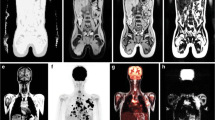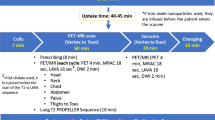Abstract
Background
Altered biodistribution of [F-18]2-fluoro-2-deoxyglucose (FDG) is sometimes encountered in pediatric patients undergoing chemotherapy for lymphoma on post-induction positron emission tomography (PET) imaging. A characteristic pattern of increased FDG uptake in white adipose tissue can be seen, particularly in the buccal regions, body wall and gluteal regions, with a shift of radiotracer away from the blood pool and liver. This altered biodistribution has been attributed to effects of corticosteroids in pediatric and adult patients and is important to recognize because of its potential for limiting the diagnostic quality of the PET scan and interfering with therapeutic response assessment.
Objective
In contrast to the well-known metabolically active brown fat seen on up to one-third of pediatric PET scans, white fat is usually non-metabolically active. We sought to determine the incidence of altered distribution of FDG in subcutaneous white adipose tissue in pediatric patients undergoing PET imaging and to assess the association with corticosteroid use.
Materials and methods
We reviewed the medical records and imaging for four children in whom altered biodistribution in white adipose tissue was present on post-induction FDG PET/CT, identified during routine clinical practice. All four were receiving corticosteroids as part of their chemotherapy. We then retrospectively reviewed oncology FDG PET/CT scans over a 2-year period (1,361 scans in 689 patients) to determine the incidence of uptake in white fat by qualitative visual assessment. In the children identified with altered biodistribution, we measured maximum standard uptake value (SUVmax) and mean standard uptake value (SUVmean) in areas of subcutaneous white fat, the buccal regions, body wall or gluteal soft-tissue regions, liver and blood pool. We reviewed all medical records, including medication lists. We summarize the relevant clinical and imaging findings of 13 pediatric patients, including the 4 index patients.
Results
We determined the incidence of FDG uptake in white fat to be rare, found in 9 of 1,361 (0.6%) PET scans performed for pediatric cancer evaluation. FDG uptake was increased in subcutaneous adipose tissue, particularly in the buccal regions, body wall and gluteal regions, with a shift of radiotracer away from the blood pool and liver. The degree of increased uptake in peripheral white fat varied from marked to mild, and the biodistribution was distinct from that of brown adipose tissue. Children with this altered biodistribution were uniformly receiving corticosteroids as part of induction treatment for their cancer, and these findings were only identified on post-induction PET/CT. Follow-up PET/CT documented resolution of this effect after treatment with corticosteroids ceased.
Conclusion
Our findings support the current understanding that characteristic uptake of FDG in white adipose tissue is mediated by corticosteroid effect. Although this altered biodistribution is rare (<1% of PET scans) it could impair the diagnostic quality of the scan, affecting image interpretation, and should be recognized when present.


Similar content being viewed by others
References
Gelfand MJ, Sharp SE (2008) Patient preparation and performance of PET/CT scans in pediatric patients. PET Clin 3:473–485
Shammas A, Lim R, Charron M (2009) Pediatric FDG PET/CT: physiologic uptake, normal variants, and benign conditions. Radiographics 29:1467–1486
Hong TS, Shammas A, Charron M et al (2011) Brown adipose tissue 18F-FDG uptake in pediatric PET/CT imaging. Pediatr Radiol 41:759–768
Grant FD (2014) Normal variations and benign findings in pediatric 18F-FDG-PET/CT. PET Clin 9:195–208
Bauwens M, Wierts R, van Royen B et al (2014) Molecular imaging of brown adipose tissue in health and disease. Eur J Nucl Med Mol Imaging 41:776–791
Haas B, Schlinkert P, Mayer P, Eckstein N (2012) Targeting adipose tissue. Diabetol Metab Syndr 4:43
Sharp SE, Gelfand MJ, Absalon MJ (2012) Altered FDG uptake patterns in pediatric lymphoblastic lymphoma patients receiving induction chemotherapy that includes very high dose corticosteroids. Pediatr Radiol 42:331–336
Hofman MS, Hicks RJ (2011) White fat, factitious hyperglycemia, and the role of FDG PET to enhance understanding of adipocyte metabolism. EJNMMI Res 1:2
Hwang DY, Lee JW, Lee SM, Kim S (2016) Causes of (18)F-FDG uptake on white adipose tissue. Hell J Nucl Med 19:7–9
Kong MC, Nadel HR (2018) 18F-FDG PET/CT with diffusely high FDG uptake throughout subcutaneous adipose tissues. Clin Nucl Med 43:762–763
Pattison DA, Hofman MS, Lau E et al (2014) Enhanced white adipose tissue metabolism in iatrogenic Cushing's syndrome with FDG PET/CT. J Clin Endocrinol Metab 99:3041–3042
Basu S (2008) Functional imaging of brown adipose tissue with PET: can this provide new insights into the pathophysiology of obesity and thereby direct antiobesity strategies? Nucl Med Commun 29:931–933
Virtanen KA (2016) The rediscovery of BAT in adult humans using imaging. Best Pract Res Clin Endocrinol Metab 30:471–477
Gilsanz V, Hu HH, Kajimura S (2013) Relevance of brown adipose tissue in infancy and adolescence. Pediatr Res 73:3–9
Lecoultre V, Ravussin E (2011) Brown adipose tissue and aging. Curr Opin Clin Nutr Metab Care 14:1–6
Hu HH (2015) Magnetic resonance of brown adipose tissue: a review of current techniques. Crit Rev Biomed Eng 43:161–181
Baba S, Jacene HA, Engles JM et al (2010) CT Hounsfield units of brown adipose tissue increase with activation: preclinical and clinical studies. J Nucl Med 51:246–250
Ahmadi N, Hajsadeghi F, Conneely M et al (2013) Accurate detection of metabolically active "brown" and "white" adipose tissues with computed tomography. Acad Radiol 20:1443–1447
Wehrli NE, Bural G, Houseni M et al (2007) Determination of age-related changes in structure and function of skin, adipose tissue, and skeletal muscle with computed tomography, magnetic resonance imaging, and positron emission tomography. Sem Nucl Med 37:195–205
Oliveira AL, Azevedo DC, Bredella MA et al (2015) Visceral and subcutaneous adipose tissue FDG uptake by PET/CT in metabolically healthy obese subjects. Obesity 23:286–289
Clarke JR, Brglevska S, Lau EW et al (2007) Atypical brown fat distribution in young males demonstrated on PET/CT. Clin Nucl Med 32:679–682
Bleeker-Rovers CP, van der Ven AJ, Zomer B et al (2004) F-18-fluorodeoxyglucose positron emission tomography for visualization of lipodystrophy in HIV-infected patients. AIDS 18:2430–2432
Sathekge M, Maes A, Kgomo M et al (2010) Evaluation of glucose uptake by skeletal muscle tissue and subcutaneous fat in HIV-infected patients with and without lipodystrophy using FDG-PET. Nucl Med Commun 31:311–314
Author information
Authors and Affiliations
Corresponding author
Ethics declarations
Conflicts of interest
None
Additional information
Publisher’s note
Springer Nature remains neutral with regard to jurisdictional claims in published maps and institutional affiliations.
Rights and permissions
About this article
Cite this article
Wong, K.K., Sedig, L.K., Bloom, D.A. et al. 18F-2-fluoro-2-deoxyglucose uptake in white adipose tissue on pediatric oncologic positron emission tomography (PET)/computed tomography (CT). Pediatr Radiol 50, 524–533 (2020). https://doi.org/10.1007/s00247-019-04574-3
Received:
Revised:
Accepted:
Published:
Issue Date:
DOI: https://doi.org/10.1007/s00247-019-04574-3




